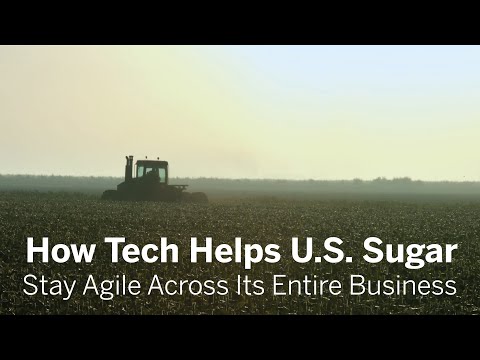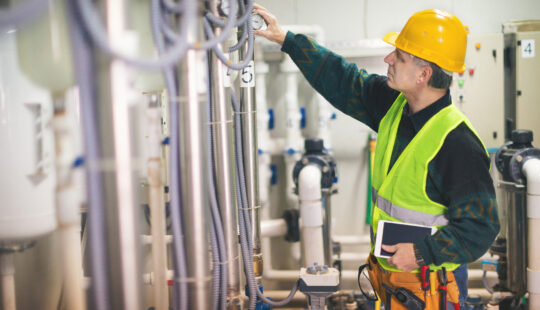The sweet tooth has been around since the dawn of humanity, but sugar only became a household staple in the 1880s. Since then, it has swiftly become an important commodity and plays a significant role in the human diet around the world.
Delivering sugar to the table has its own challenges. One company that has been hitting the mark decade after decade is U.S. Sugar, a family business located in the center of Florida. One of the largest agricultural operations in the state, the company owns 230,000 acres of land where sugarcane farming and refining operations run 24/7.
“We’ve been growing sugarcane for 90 years, and we’ve been innovative from the start,” says Carl Stringer, a company executive who has a dual task as vice president of IT and Employee Benefits at U.S. Sugar. “We’ve been an early adopter of high-tech in our operations, thanks to our 270-square-mile area of a privately owned Wi-Fi network.”

Technology
U.S. Sugar is operating in a volatile market. The company supplies about 10% of the 8.4 million metric tons of sugar produced in the United States annually – a commodity whose price can vary depending on weather conditions, agricultural supply cycles, government policies, and currency rates.
Today, all commodity businesses are facing numerous challenges, from climate change and carbon emissions to COVID-19 lockdowns, along with operational risks in their supply chains. That’s why digitalizing, automating, and increasing efficiencies across the business are crucial to their success. Soft commodities like sugar, meaning that it is grown rather than mined, face additional challenges that are specific to agricultural businesses. Climate is one of them.
“We aim to process the freshest cane in the world, so we must always harvest at the optimal time. That requires complete flexibility,” explains Stringer. “Our growing season can include hurricanes, unexpected frosts, and flooding.”
The company relies on technology to maintain agility in every aspect of their business. U.S. Sugar is a longtime member of the SAP Agribusiness Industry Advisory Council. Stringer is deeply appreciative of the collaborative engagement. “SAP knows that agriculture is underserved by technology,” he says. “We’ve had to develop many apps simply because there’s a lack of digital farming tools. Being part of the council allows us to shape the technology based on our needs and our expertise in agriculture.”
Together with SAP, U.S. Sugar and other members of the council are integrating key agricultural processes such as planting, fertilizing, irrigating, and harvesting with the enterprise resource planning (ERP) elements of their supply chain such as automatic ordering through direct links to suppliers.
Digitalization is an enabler for efficient and sustainable farming processes. “Farming is still far behind when it comes to digital capabilities,” says Stringer, whose goal is to increase efficiency in all areas to balance the huge costs of fuel, labor, and soil amendments that are typical for the industry. That’s why SAP technology is a key enabler when it comes to automation, quality management, and the management of assets including the company’s 800 vehicles.
Environment
One of company’s main challenges is educating the public about the sustainability of their operations. Conservationists around the world are concerned about sugarcane farming because, in some countries, sugar mills produce wastewater, emissions, and solid waste that impact the environment. Also, there are questions as to whether the energy needed to produce sugarcane is high in comparison to other crops such as potatoes or wheat.
Fortunately, the U.S. Sugar mill and refinery in Clewiston, Florida, is a zero-discharge facility with no water or waste leaving the property. Florida’s sugar industry has been a trailblazer in sustainable best practices as it relates to environmental restoration. U.S. Sugar often stands as a model for its sustainable practices, with a proven track record of more than 90 years farming the land around Lake Okeechobee.
“We are keenly committed to preserving the natural beauty of the Everglades,” says Stringer. “Clean water is fundamental to this ecosystem and to our farming business. Every drop of water flowing off our land is measured and regulated and cleaned. In fact, we go beyond meeting regulations, ensuring that our environment is the cleanest it’s been in our lifetimes. The water today is as clean as rainwater.”
The best way to counter misperception is to educate and inform. The company regularly conducts tours of its operations, inviting schools, local community residents, and other interested parties to visit and see for themselves. Thousands of Floridians tour U.S. Sugar’s farming operations each year.
U.S. Sugar is also self-sufficient when it comes to energy. Cane stalk waste is repurposed to generate steam and electricity, replacing the need for purchased electricity or fossil fuels to power its sugar processing facilities. The company has even rebuilt a historic steam-powered locomotive to transport cane and visitors around its operations. All farming and factory operations run on sophisticated machinery that is 100% integrated into the business. This enables U.S. Sugar to manage water, crop, and postharvest logistics more holistically, which in turn allows the company to compete more effectively in the face of volatile worldwide commodities prices.
“Technology is a key enabler because it delivers deep insights into all business and operational areas,” says the head of IT. “We can respond in real time thanks to the intelligent integration of sensors, control systems, and dashboards.”
Philanthropy
Besides caring for the environment, Stringer points out that the way to remain relevant in the future is to build the necessary skill set today. The company employs around 2,000 people who have their own special stake in the company: they own it along with two other primary stakeholders, the Charles Stewart Mott Foundation and the Mott Children’s Health Center.
Charles Stewart Mott, the industrialist and philanthropist, established his foundation in 1926 to support non-profit educational organizations around the country. Today, the foundation funds numerous educational and environmental efforts to promote a just, equitable, and sustainable society.
The good work does not stop there. U.S. Sugar is currently exploring ways to become even more efficient through circular production models. One is to make better use of bagasse, the dry, pulpy, fibrous material that remains after crushing sugarcane stalks to extract their juice, and the soil matter that is extracted from the cane during the clarification process, commonly known as mill mud. These two elements are comingled in a proprietary method and then returned to the cane fields as an efficient and eco-friendly compost. Bagasse can also be burned as fuel in the sugarcane mill or used as a source of cellulose for manufacturing animal feeds.
As someone responsible for people and IT, Stringer sees beyond the monetary value of digitalization. It increases user satisfaction and engagement, decreases resistance to change, and strengthens the relationship between IT and the business. Connecting people and technology and caring for the environment is what enables U.S. Sugar to remain faithful to its tradition of innovating for a sustainable future.



